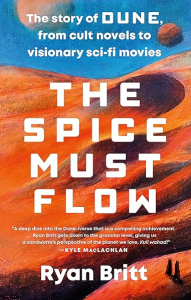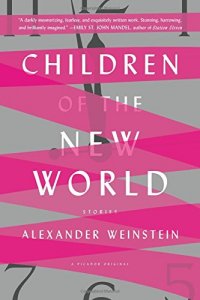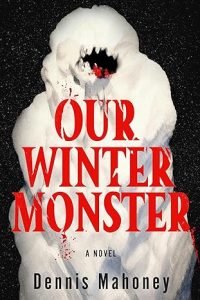Alvaro Zinos-Amaro Reviews The Spice Must Flow: The Story of Dune, from Cult Novels to Visionary Sci-Fi Movies by Ryan Britt
 The Spice Must Flow: The Story of Dune, from Cult Novels to Visionary Sci-Fi Movies, Ryan Britt (Plume 978-0593472996, $18.00, 288pp, pb) September 2023.
The Spice Must Flow: The Story of Dune, from Cult Novels to Visionary Sci-Fi Movies, Ryan Britt (Plume 978-0593472996, $18.00, 288pp, pb) September 2023.
In 13 breezy chapters, Ryan Britt traces Dune from its original conception as a non-fiction piece by Frank Herbert titled ‘‘They Stopped the Moving Sands’’ to its latest multi-installment cinematic adaptation at the hands of director Denis Villeneuve. ‘‘What I hope lifelong fans get from this book,’’ Britt writes in the prefatory Author’s Note, ‘‘is a larger view of the sweep of the Dune phenomenon and how its journey is as improbable as it is amazing. I hope, by experiencing the real-life story of Dune, you fall in love with the science fiction world of the novels, films, and TV versions all over again.’’ This is not to say that newer fans should be intimidated: ‘‘This book is very much for you, too…. Dune is for everyone, and it always has been.’’
The first four chapters, roughly speaking, give us the background on Frank Herbert’s family life and writing prior to and during 1957-1965, the period during which the original non-fiction piece evolved into the novel finally published by Chilton Books. For those interested in Dune’s complicated literary genesis, and a breakdown of the differences between Herbert’s various short story treatments and pitches, this may be the book’s most involving section. We learn that ‘‘for much of Herbert’s writing career, there was inconsistency and failure,’’ and his second wife, Beverly, kept things afloat. By 1962, ‘‘Herbert had published a total of twenty more science fiction stories and novellas in every leading SF magazine of the era,’’ but Britt goes on to assess that ‘‘despite his impressive, prolific output of fiction, and the plethora of imaginative concepts in those published stories, the bulk of that writing is simply not that great.’’ In Chapter 3, while discussing literary context, Britt opines that ‘‘because Dune’s backstory rejects computers and artificial intelligence while downplaying the specifics of spaceflight, Herbert was, in many ways, the most important New Wave science fiction writer of them all,’’ a somewhat reductive and contentious claim. Britt makes a more convincing case, that following the Analog serialization, Chilton’s Sterling E. Lanier was ‘‘perhaps the most important person in Dune history.’’
Chapter 5 discusses Herbert’s first sequel, Dune Messiah, which interestingly inverted ‘‘the perceived underdog triumph of the first novel,’’ but sold sluggishly and received lukewarm reviews. Next we explore various 1970s movie treatments that never came to be, the second sequel and conclusion of the original trilogy, Children of Dune, best-sellerdom, David Lynch’s ambitious but deeply flawed film adaptation, the second Dune trilogy and the death of Beverly, Herbert’s third marriage (to Theresa Shackleford), the two television miniseries adaptations, and finally the 2021 feature film. Movie buffs will find interesting tidbits in these sections, such as the fact that when Ridley Scott was trying to develop his film adaptation, he asked Harlan Ellison to write the screenplay and Ellison ‘‘turned him down flat.’’
Every chapter is peppered with numerous original quotes, mostly from folks, like Kyle MacLachlan, Timothée Chalamet, Alec Newman, Alicia Witt, Patrick Stewart, John Harrison, Rebecca Ferguson, and Denis Villeneuve, who have been involved in visual interpretations of Herbert’s material. A few authors and scholars – Alec Nevala-Lee, Kara Kennedy, Emmet Asher-Perrin, Haris Durrani, Bill Ransom – are also passed the mic from time to time. The entertainment-industry interviews range from informative to distracting. In a comparison that will date me beyond reason for most readers, I’ll say that the sheer volume of quotes at times makes the book feel like one of those old Starlog celebrity articles or books like Star Trek’s Greatest Guest Stars (1996). Judicious trimming might have helped here, along with fewer repetitions. In Chapter 1, for example, Herbert is quoted as saying, ‘‘We all know that many religions began in a desert atmosphere’’; this quote is then repeated in Chapter 3. In Chapter 5, Nevala-Lee is cited as follows: ‘‘If Frank Herbert was trying to criticize white savior narratives with [the first] Dune, he probably could have done a better job.’’ This quote is also repeated, with slightly different wording, in Chapter 13. And so on.
On the whole, one of the book’s strengths is the work Britt does to cut through Herbert’s own tendency towards historical revisionism regarding Dune’s original conception and development. A lot of work and research has clearly gone into finding primary sources that either illustrate accounts at odds with one another, or suggest situational modifications of narratives to serve specific purposes, for which Britt should be applauded. In a few instances, I would have enjoyed additional detail. For instance, Britt mentions that ‘‘the science fiction community inconsistently embraced Herbert in the late sixties,’’ but this follows Herbert winning both the Hugo and Nebula awards for Dune, so some elaboration would have been welcome. In Chapter 11, Britt explains that ‘‘as of 2023, there are a total of sixteen Dune novels written by Brian Herbert and Kevin J. Anderson, of which only two – Hunters of Dune and Sandworms of Dune – are sequels to Frank Herbert’s original six novels.’’ I think readers would benefit from at least a schematic breakdown of how these novels are grouped into trilogies or story cycles and where they fit into the overall timeline. I didn’t see any commentary on Ed Naha’s The Making of Dune (1984), even if just to survey its limitations, and found no mention of the recent graphic novels or comic book film adaptations, despite the fact that the book skews heavy towards media coverage. Hans Zimmer is interviewed briefly; readers might appreciate learning of the unprecedented existence of three different soundtrack releases related to Dune (2021): the film’s score, an extended ‘‘sketchbook’’ of musical ideas, and a soundtrack conceived explicitly as a companion to the limited edition of Tanya Lapointe’s The Art and Soul of Dune (2021).
But those are details. This volume accomplishes what it sets out to do. If you have even a passing interest in Dune’s convoluted saga, you’ll find something to enjoy. In one of his more esoteric moments, Britt writes that ‘‘the true feature that makes Dune so fascinating is that it not only has ensured its own survival but also, perhaps, created itself.’’ On the contrary, it is the enduring engagement by fans and pop culture aficionados like Britt that keep Dune from wandering lost through the desert.
Alvaro Zinos-Amaro, Roundtable Editor, is co-author of a book of interviews with Robert Silverberg, Traveler of Worlds, that was a Hugo and Locus Award finalist in 2017. Alvaro’s more than 30 stories and 100 reviews, essays and interviews have appeared in magazines like Clarkesworld, Asimov’s, Apex, Analog, Lightspeed, Nature, Strange Horizons, Beneath Ceaseless Skies, Galaxy’s Edge, Lackington’s, and anthologies such as The Year’s Best Science Fiction & Fantasy 2016, Cyber World, Humanity 2.0, and This Way to the End Times.
This review and more like it in the September 2023 issue of Locus.
 While you are here, please take a moment to support Locus with a one-time or recurring donation. We rely on reader donations to keep the magazine and site going, and would like to keep the site paywall free, but WE NEED YOUR FINANCIAL SUPPORT to continue quality coverage of the science fiction and fantasy field.
While you are here, please take a moment to support Locus with a one-time or recurring donation. We rely on reader donations to keep the magazine and site going, and would like to keep the site paywall free, but WE NEED YOUR FINANCIAL SUPPORT to continue quality coverage of the science fiction and fantasy field.
©Locus Magazine. Copyrighted material may not be republished without permission of LSFF.







